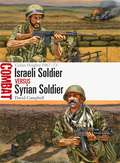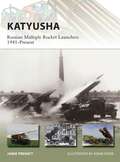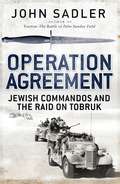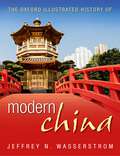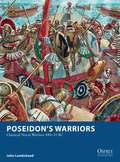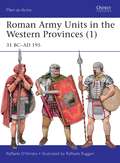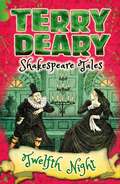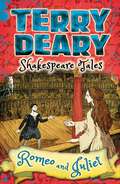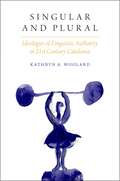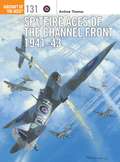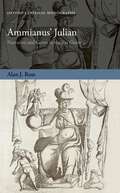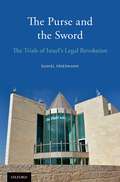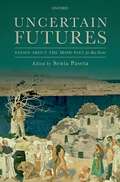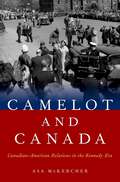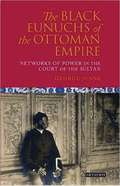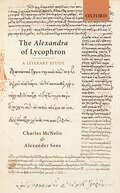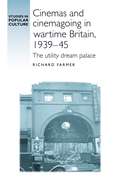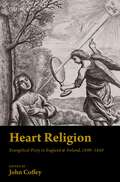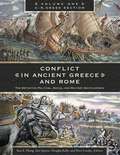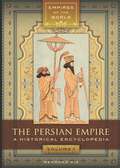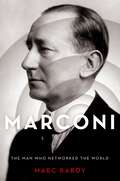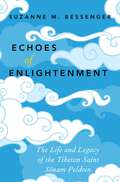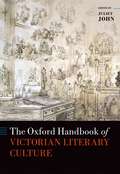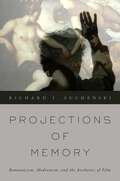- Table View
- List View
Israeli Soldier vs Syrian Soldier: Golan Heights 1967–73 (Combat #18)
by Johnny Shumate David CampbellIsrael seized the strategically critical Golan Heights from Syria during the 1967 Six Day War in an audacious and determined operation, yet when the Yom Kippur War broke out the Israeli military were exposed by the effectiveness of the newly confident and dangerous Syrian army. In the Golan only luck, herculean Israeli efforts and tactical misjudgements by the Syrians were to allow the Israelis to maintain control. In this book, three pivotal encounters in the Golan are assessed, supported by artwork, maps and photographs, tracking how both sides' forces evolved over the period.
Katyusha: Russian Multiple Rocket Launchers 1941–Present (New Vanguard)
by Adam Hook Jamie PrenattAlthough military rockets have been used since the Middle Ages, it was not until the Soviet Union pioneered the concept of Multiple Rocket Launchers (MRLs) in the late 1930s that they emerged as a decisive weapon. In the modern era, these Soviet/Russian Katyushas have served in combat in Afghanistan, Chechnya, and Georgia.Developed to fill the operational need for massed artillery fire support, the MRL possesses enormous destructive power and a devastating psychological impact. This New Vanguard provides a survey of Soviet and Russian Federation MRLs from the beginning of their development in 1941 to the present. It focuses on the history, design, and specifications of self-propelled ground MRL systems, but also covers towed, static, railway, and naval mounts. It highlights the many variants of the principal systems and include MRL unit tables of organization and equipment, information on MRL munition types, and coverage of dedicated MRL resupply vehicles.
Operation Agreement: Jewish Commandos and the Raid on Tobruk
by John SadlerThe Special Interrogation Group (SIG) was the most exceptional of Special Forces. Created to raid behind enemy lines posing as German troops, the SIG was largely made up of German Jews who were all too aware of the dangers they faced – capture meant either death or deportation to a concentration camp. In 1942, Operation Agreement saw the SIG tasked with taking part in a raid on Tobruk, where they were to make up the land-based element of the attack. Disguised as POWs under escort by German-speaking SIGs the group covered close to 1,700 miles of desert to reach their target. The ruse worked perfectly and the SIG went on to destroy a number of coastal guns before eventually being overwhelmed by Axis forces. This is the history of the SIG, revealing startling details about the group and offering moving insights into the Jewish volunteers putting their lives on the line to fight against the evils of Nazism.
The Oxford Illustrated History of Modern China (Oxford Illustrated History)
This lavishly illustrated volume explores the history of China during a period of dramatic shifts and surprising transformations, from the founding of the Qing Dynasty (1644-1912) through to the present day. The Oxford Illustrated History of Modern China promises to be essential reading for anyone who wants to understand this rising superpower on the verge of what promises to be the 'Chinese century', introducing readers to important but often overlooked events in China's past, such as the bloody Taiping Civil War (1850-1864), which had a death toll far higher than the roughly contemporaneous American Civil War. It also helps readers see more familiar landmarks in Chinese history in new ways, such as the Opium War (1839-1842), the Boxer Uprising of 1900, the rise to power of the Chinese Communist Party in 1949, and the Tiananmen protests and Beijing Massacre of 1989. This is one of the first major efforts — and in many ways the most ambitious to date — to come to terms with the broad sweep of modern Chinese history, taking readers from the origins of modern China right up through the dramatic events of the last few years (the Beijing Games, the financial crisis, and China's rise to global economic pre-eminence) which have so fundamentally altered Western views of China and China's place in the world.
Poseidon’s Warriors: Classical Naval Warfare 480–31 BC (Osprey Wargames)
by John LambsheadPoseidon's Warriors is a set of wargaming rules for large-scale naval actions between fleets of Classical galleys from the Greek and Persian clash at the battle of Salamis to the battle of Actium that decided the fate of Rome. With so many of these battles taking place around islands or in narrow channels and shallow waters, sneaky tactics and cunning manoeuvres are a hallmark of warfare of this era, and the rules use an integrated turn system to allow a commander to position ships to go in and ram without being rammed in return, or to employ feints and traps to tempt the enemy out of position and leave his ships vulnerable to a follow-up strike. With data for ships throughout the period, rules for famous admirals, historical scenarios, a campaign system and a brief historical summary for those who wish to refresh their memory of the era, Poseidon's Warriors offers everything players need to bring to the tabletop the battles and campaigns of the first great age of naval warfare.
Roman Army Units in the Western Provinces: 31 BC–AD 195 (Men-at-Arms)
by Raffaele Ruggeri Raffaele D’AmatoAt its height the Roman Empire stretched across Europe, North Africa and the Middle East, maintained by an army of modest size but great diversity. In popular culture these soldiers are often portrayed in a generic fashion,but continuing research indicates significant variations in Roman armour and equipment not only between different legions and the provincially-raised auxiliary cohorts that made up half of the army, but also between different regions within the empire. With reference to the latest archaeological and documentary evidence Dr D'Amato investigates how Roman Army units in the Western provinces were equipped, exploring the local influences and traditions that caused the variations in attire.
Shakespeare Tales: Twelfth Night (Shakespeare Tales)
by Terry DearyFrom the bestselling author of Horrible Histories...Jane and John have uncovered a wicked plot to steal the throne from Queen Elizabeth I of England while she watches a play. Can they stop it in time? Meanwhile, on stage, Olivia loves the boy Caesario, who is in fact not a boy but a girl, Viola. Viola loves Orsino but Orsino loves Olivia. What a tangle, what a jumble… Terry Deary's Shakespeare Tales explore the fascinating world of William Shakespeare through the eyes of children who could have lived at the time. Join master storyteller Terry Deary for a trip back in time to Queen Elizabeth's court, where everyone is up to something and they could be up to no good! This edition features notes for the reader to help extend learning and exploration of the historical period.
Shakespeare Tales: Romeo and Juliet (Shakespeare Tales)
by Terry DearyFrom the bestselling author of Horrible Histories...Down at the theatre, Sam is about to star in Shakespeare's new play, Romeo and Juliet, but people are whispering that a plague is spreading through the city. Will Sam get his big break or will the plague shut down the theatre? Meanwhile, on stage, Romeo and Juliet are in love but their families can't stand each other. With plots and poison, the lovers must find a way to be together. Terry Deary's Shakespeare Tales explore the fascinating world of William Shakespeare through the eyes of children who could have lived at the time. Join master storyteller Terry Deary for a trip back in time to plague ridden-London where going to the theatre could be a matter of life or death! This edition features notes for the reader to help extend learning and exploration of the historical period.
Singular and Plural: Ideologies of Linguistic Authority in 21st Century Catalonia (Oxf Studies in Anthropology of Language)
by Kathryn A. WoolardWinner of the Ramon Llull International Prize Winner of the 2017 Society for Linguistic Anthropology Edward Sapir Book Prize A vibrant and surprisingly powerful civic and political movement for an independent Catalonia has brought renewed urgency to questions about what it means, personally and politically, to speak or not to speak Catalan and to claim Catalan identity. In this book, Kathryn Woolard develops a framework for analyzing ideologies of linguistic authority and uses it to illuminate the politics of language in Spain and Catalonia, where Catalan jostles with Castilian for legitimacy. Longitudinal research across decades of political autonomy contextualizes this ethnographic study of the social meaning of Catalan in the 21st century. Part I lays out the ideologies of linguistic authenticity, anonymity, and naturalism that typically underpin linguistic authority in the modern western world, and gives an overview of a shift in the ideological grounding of linguistic authority in contemporary Catalonia. Part II examines discourses in the media surrounding three public linguistic controversies: an immigrant president's linguistic competence, a municipal festival, and an international book fair. Part III explores individuals' linguistic practices and views, drawing on classroom ethnographies and interviews with two generations of young people from the same high school. The book argues that there is an ongoing shift at both public and personal levels away from the ethnolinguistic authenticity that powered relations in the early transition to political autonomy, and toward new discourses of anonymity, rooted cosmopolitanism, and authenticity understood as a project rather than a matter of origins and essence. This shift is reflected in the current sovereignty movement.
Spitfire Aces of the Channel Front 1941-43 (Aircraft of the Aces #131)
by Andrew Thomas Mark Postlethwaite Chris Thomas80 years after the Spitfire was first developed it remains an icon of military aviation. Though many associate its victory during the Battle of Britain as the high point in the history of the Spitfire, the years following were of equal importance. Having weathered the initial storm, at the start of 1941 Fighter Command took the fight to the Germans with offensive missions over the Channel.This book reveals how first using the Spitfire I and II, and then following the introduction of the Bf 109 the cannon-armed Spitfire V, RAF squadrons embarked on a range of missions which included one of the most important air battles of the war, over Dieppe on 19 August 1942. Alongside British pilots were squadrons manned by exiled Europeans and pilots from the RAAF, RCAF and RNZAF. In just three years over 100 of these pilots were to rack up ace status in the Spitfire.
Ammianus' Julian: Narrative and Genre in the Res Gestae (Oxford Classical Monographs)
by Alan J. RossAmmianus Marcellinus' Res Gestae holds a prominent position in modern studies of the emperor Julian as the fullest extant narrative of the reign of the last 'pagan' emperor. Ammianus' Julian: Narrative and Genre in the Res Gestae offers a major reinterpretation of the work, which is one of the main narrative sources for the political history of the later Roman Empire, and argues for a re-examination of Ammianus' agenda and methods in narrating the reign of Julian. Building on recent developments in the application of literary approaches and critical theories to historical texts, Ammianus' presentation of Julian is evaluated by considering the Res Gestae within three interrelated contexts: as a work of Latin historiography, which consciously sets itself within a classical and classicizing generic tradition; in a more immediate literary and political context, as the final contribution by a member of an 'eyewitness' generation to a quarter century of intense debate over Julian's legacy by several authors who had lived through his reign and had been in varying degrees of proximity to Julian himself; and as a narrative text, in which narratorial authority is closely associated with the persona of the narrator, both as an external narrating agent and an occasional participant in the events he relates. This is complemented by a literary survey and a re-analysis of Ammianus' depiction of several key moments in Julian's reign, such as his appointment as Caesar, the battle of Strasbourg in 357AD, his acclamation as Augustus, and the disastrous invasion of Persia in 363AD. It suggests that the Res Gestae presents a Latin-speaking, western audience with an idiosyncratic and 'Romanized' depiction of the philhellene emperor and that, consciously exploiting his position as a Greek writing in Latin and as a contemporary of Julian, Ammianus wished his work to be considered a culminating and definitive account of the man and his life.
The Purse and the Sword: The Trials of Israel's Legal Revolution
by Daniel FriedmannThe Purse and the Sword presents a critical analysis of Israel's legal system in the context of its politics, history, and the forces that shape its society. This book examines the extensive powers that Israel's Supreme Court arrogated to itself since the 1980s and traces the history of the transformation of its legal system and the shifts in the balance of power between the branches of government. Centrally, this shift has put unprecedented power in the hands of both the Court and Israel's attorney general and state prosecution at the expense of Israel's cabinet, constituting its executive branch, and the Knesset--its parliament. The expansion of judicial power followed the weakening of the political leadership in the wake of the Yom Kippur war of 1973, and the election results in the following years. These developments are detailed in the context of major issues faced by modern Israel, including the war against terror, the conflict with the Palestinians, the Arab minority, settlements in the West Bank, state and religion, immigration, military service, censorship and freedom of expression, appointments to the government and to public office, and government policies. The aggrandizement of power by the legal system led to a backlash against the Supreme Court in the early part of the current century, and to the partial rebalancing of power towards the political branches.
Uncertain Futures: Essays about the Irish Past for Roy Foster
This volume has been produced to mark the retirement of Roy Foster from the Carroll Professorship of Irish history at the University of Oxford, and to mark his extraordinary career as a historian, literary critic, and public intellectual. It consists of twenty three essays contributed by many of the leading historians of modern Ireland, including scholars whose work has influenced Roy Foster's own research, leading Irish historians who have influenced and have been influenced by Foster, and younger scholars who were supervised and/or mentored by Roy and whose work he greatly admires. Essays chart Foster's career while reflecting on developments in the field of Irish history writing, teaching, and research since the 1970s. Focussing on the history of Ireland since 1800, these essays cover a wide spectrum of topics and ideas including aspects of the Irish land question, generational and intellectual tensions, political biography, and social and cultural change.
Camelot and Canada: Canadian-American Relations in the Kennedy Era
by Asa McKercherIn 1958 Senator John F. Kennedy of Massachusetts proclaimed at the University of New Brunswick that "Canada and the United States have carefully maintained the good fences that help make them good neighbours." He could not have foreseen that his presidency would be marked not just by some of the tensest moments of the Cold War but also by the most contentious moments in the Canadian-American relationship. Indeed, the 1963 Canadian federal election was marked by charges that the US government had engineered a plot to oust John Diefenbaker, Canada's nationalist prime minister. Camelot and Canada explores political, economic, and military elements in Canada-US relations in the early 1960s. Asa McKercher challenges the prevailing view that US foreign policymakers, including President Kennedy, were imperious in their conduct toward Canada. Rather, he shows that the period continued to be marked by the special diplomatic relationship that characterized the early postwar years. Even as Diefenbaker's government pursued distinct foreign and economic policies, American officials acknowledged that Canadian objectives legitimately differed from their own and adjusted their policies accordingly. Moreover, for all its bluster, Ottawa rarely moved without weighing the impact that its initiatives might have on Washington. At the same time, McKercher illustrates that there were significant strains on the bilateral relationship, which occurred as a result of mounting doubts in Canada about US leadership in the Cold War, growing Canadian nationalism, and Canadian concern over their country's close economic, military, and cultural ties with the United States. While personal clashes between the two leaders have become mythologized by historians and the public alike, the special relationship between their governments continued to function.
The Black Eunuchs of the Ottoman Empire: Networks of Power in the Court of the Sultan
by George H. JunneThe Chief Black Eunuch, appointed personally by the Sultan, had both the ear of the leader of a vast Islamic Empire and held power over a network of spies and informers, including eunuchs and slaves throughout Constantinople and beyond. The story of these remarkable individuals, who rose from difficult beginnings to become amongst the most powerful people in the Ottoman Empire, is rarely told. George Junne places their stories in the context of the wider history of African slavery, and places them at the centre of Ottoman history. The Black Eunuchs of the Ottoman Empire marks a new direction in the study of courtly politics and power in Constantinople.
The Alexandra of Lycophron: A Literary Study
by Charles McNelis Alexander SensThis monograph is a literary study of Lycophron's Alexandra, whose obscurity, a quality notorious already in antiquity, has long hampered holistic approaches. Through a series of distinct but closely integrated literary studies of major aspects of the poem, including its style, its engagement with the traditions of epic and tragedy, and it's treatment of heroism and of the gods, the book explores the way the Alexandra reconfigures Greek mythology. In particular, as it is presented in Homeric epic and Athenian tragedy, in order to cast the Romans and their restoration of Trojan glory as the ultimate telos of history. In this sense, the poem emerges as an important intermediary between Homeric epic and Latin poetry, particularly Vergil's Aeneid. By rewriting specific features of the epic and tragic traditions, the Alexandra denies to Greek heroes the glory that was the traditional compensation for their suffering, while at the same time attributing to Cassandra's Trojan family honours framed in the traditional language of Greek heroism. In this sense, the figure of Cassandra, a prophetess traditionally gifted with the power of foresight but denied credibility, self-reflexively serves as a vehicle for exploring the potentials and limitations of poetry.
Cinemas and cinemagoing in wartime Britain, 1939–45: The utility dream palace (Studies in Popular Culture)
by Richard FarmerDuring the Second World War, the popularity and importance of the cinema in Britain was at its peak. In this groundbreaking book, Richard Farmer provides a social and cultural history of cinemas and cinemagoing in Britain between 1939 and 1945, and explores the impact that the war had on the places in which British people watched films. Although promising the possibility of escape from the hardships and terrors of wartime life, the cinema was so intimately woven into the fabric of British society that it could not itself escape the war. Drawing on a wealth of contemporary sources, and on the memories of wartime cinemagoers, Cinemagoing in wartime Britain, 1939-45 is the first book to offer an in-depth exploration of the impact that phenomena such as the black out, the blitz, food rationing, evacuation and conscription had on both the exhibition industry and the experiences of the picturegoers themselves.
Heart Religion: Evangelical Piety in England & Ireland, 1690-1850
The Evangelical Revival of the mid-eighteenth century was a major turning point in Protestant history. In England, Wesleyan Methodists became a separate denomination around 1795, and Welsh Calvinistic Methodists became independent of the Church of England in 1811. By this point, evangelicalism had emerged as a major religious force across the British Isles, making inroads among Anglicans as well as Irish and Scottish Presbyterians. Evangelical Dissent proliferated through thousands of Methodist, Baptist, and Congregational churches; even Quakers were strongly influenced by evangelical religion. The evangelicals were often at odds with each other over matters of doctrine (like the 'five points' of Calvinism); ecclesiology (including the status of the established church); politics (as they reacted in various ways to the American and French Revolutions); and worship (with the boisterous, extemporary style of Primitive Methodists contrasting sharply with the sober piety of many Anglican advocates of 'vital religion'). What they shared was a cross-centred, Bible-based piety that stressed conversion and stimulated evangelism. But how was this generic evangelical ethos adopted and reconfigured by different denominations and in very different social contexts? Can we categorise different styles of 'heart religion'? To what extent was evangelical piety dependent on the phenomenon of 'revival'? And what practical difference did it make to the experience of dying, to the parish community, or to denominational politics? This collection addresses these questions in innovative ways. It examines neglected manuscript and print sources, including handbooks of piety, translations and abridgements, conversion narratives, journals, letters, hymns, sermons, and obituaries. It offers a variety of approaches, reflecting a range of disciplinary expertise—historical, literary, and theological. Together, the contributions point towards a new account of the roots and branches of evangelical piety, and offer fresh ways of analysing the history of Protestant spirituality.
Conflict in Ancient Greece and Rome [3 volumes]: The Definitive Political, Social, and Military Encyclopedia [3 volumes]
The complex role warfare played in ancient Greek and Roman civilizations is examined through coverage of key wars and battles; important leaders, armies, organizations, and weapons; and other noteworthy aspects of conflict.Conflict in Ancient Greece and Rome: The Definitive Political, Social, and Military Encyclopedia is an outstandingly comprehensive reference work on its subject. Covering wars, battles, places, individuals, and themes, this thoroughly cross-referenced three-volume set provides essential support to any student or general reader investigating ancient Greek history and conflicts as well as the social and political institutions of the Roman Republic and Empire. The set covers ancient Greek history from archaic times to the Roman conquest and ancient Roman history from early Rome to the fall of the Western Roman Empire in 476 CE. It features a general foreword, prefaces to both sections on Greek history and Roman history, and maps and chronologies of events that precede each entry section. Each section contains alphabetically ordered articles—including ones addressing topics not traditionally considered part of military history, such as "noncombatants" and "war and gender"—followed by cross-references to related articles and suggested further reading. Also included are glossaries of Greek and Latin terms, topically organized bibliographies, and selected primary documents in translation.
The Persian Empire [2 volumes]: A Historical Encyclopedia [2 volumes] (Empires of the World)
by Mehrdad KiaThis well-balanced reference on ancient Persia demonstrates the region's contributions to the growth and development of human civilization from the 7th century BCE through the fall of the Persian Sasanian Empire in 651CE.Knowledge of ancient Persia is often gleaned from the writings of the ancient Greeks and Romans—two civilizations that viewed the Persians as enemies. This one-of-a-kind reference provides unbiased coverage of the cultural history of the Persian Empire, examining the Median, Achaemenid, Parthian, Kushan, and Sasanian dynasties and tracing the development and maturation of Iranian societies during a period of nearly 1,500 years. As one of the most comprehensive studies on the topic, this historical overview explores the region's rich past while providing insight into the cultures and civilizations the Persians came to rule and influence.Using primary sources written and inscribed by the ancient Persians themselves, the encyclopedia studies the pre-Islamic civilizations of Iran in the Middle East, the Caucasus, Central Asia, and the Indian subcontinent. Incorporating contributions from scholars who discuss the rise and fall of various Persian dynasties, the work offers some 180 entries that cover such topics as religion, royal nobility, the caste system, and political assassinations. The content offers perspectives from a variety of disciplines—from anthropology to archaeology, geography, and art history, among other areas.
Marconi: The Man Who Networked the World
by Marc RaboyA little over a century ago, the world went wireless. Cables and all their limiting inefficiencies gave way to a revolutionary means of transmitting news and information almost everywhere, instantaneously. By means of "Hertzian waves," as radio waves were initially known, ships could now make contact with other ships (saving lives, such as on the doomed S.S. Titanic); financial markets could coordinate with other financial markets, establishing the price of commodities and fixing exchange rates; military commanders could connect with the front lines, positioning artillery and directing troop movements. Suddenly and irrevocably, time and space telescoped beyond what had been thought imaginable. Someone had not only imagined this networked world but realized it: Guglielmo Marconi. As Marc Raboy shows us in this enthralling and comprehensive biography, Marconi was the first truly global figure in modern communications. Born to an Italian father and an Irish mother, he was in many ways stateless, working his cosmopolitanism to advantage. Through a combination of skill, tenacity, luck, vision, and timing, Marconi popularized--and, more critically, patented--the use of radio waves. Soon after he burst into public view at the age of 22 with a demonstration of his wireless apparatus in London, 1896, he established his Wireless Telegraph & Signal Company and seemed unstoppable. He was decorated by the Czar of Russia, named an Italian Senator, knighted by King George V of England, and awarded the Nobel Prize for Physics--all before the age of 40. Until his death in 1937, Marconi was at the heart of every major innovation in electronic communication, courted by powerful scientific, political, and financial interests. He established stations and transmitters in every corner of the globe, from Newfoundland to Buenos Aires, Hawaii to Saint Petersburg. Based on original research and unpublished archival materials in four countries and several languages, Raboy's book is the first to connect significant parts of Marconi's story, from his early days in Italy, to his groundbreaking experiments, to his protean role in world affairs. Raboy also explores Marconi's relationshps with his wives, mistresses, and children, and examines in unsparing detail the last ten years of the inventor's life, when he returned to Italy and became a pillar of Benito Mussolini's fascist regime. Raboy's engrossing biography, which will stand as the authoritative work of its subject, proves that we still live in the world Marconi created.
Echoes of Enlightenment: The Life and Legacy of the Tibetan Saint Sonam Peldren
by Suzanne M. BessengerEchoes of Enlightenment explores the issues of gender and sainthood raised by the recently discovered "liberation story" of the fourteenth-century Tibetan female Buddhist practitioner Sönam Peldren. Born in 1328, Sönam Peldren spent most of her adult life as a nomad in eastern Tibet until her death in 1372. She is believed to have been illiterate, lacking religious education, and unconnected to established religious institutions. For that reason, and because as a woman her claims of religious authority would have been constantly questioned, Sönam Peldren's success in legitimizing her claims of divine identity appear all the more remarkable. Today the site of her death is recognized as sacred by local residents. Suzanne Bessenger draws on the new-found biography of the saint to understand how the written record of the saint's life is shaped both by the hagiographical agendas of its multiple authors and by the dictates of the genres of Tibetan religious literature, including biography and poetry. She considers Sönam Peldren's enduring historical legacy as a fascinating piece of Tibetan history that reveals much about the social and textual machinations of saint production. Finally, she identifies Sönam Peldren as one of the earliest recorded instances of a historical Tibetan woman successfully using the uniquely Tibetan hermeneutic of deity emanation to achieve religious authority.
The Oxford Handbook of the Age of Shakespeare (Oxford Handbooks)
The Oxford Handbook of the Age of Shakespeare presents a broad sampling of current historical scholarship on the period of Shakespeare's career that will assist and stimulate scholars of his poems and plays. Rather than merely attempting to summarize the historical 'background' to Shakespeare, individual chapters seek to exemplify a wide variety of perspectives and methodologies currently used in historical research on the early modern period that can inform close analysis of literature. Different sections examine political history at both the national and local levels; relationships between intellectual culture and the early modern political imagination; relevant aspects of religious and social history; and facets of the histories of architecture, the visual arts, and music. Topics treated include the emergence of an early modern 'public sphere' and its relationship to drama during Shakespeare's lifetime; the role of historical narratives in shaping the period's views on the workings of politics; attitudes about the role of emotion in social life; cultures of honour and shame and the rituals and literary forms through which they found expression; crime and murder; and visual expressions of ideas of moral disorder and natural monstrosity, in printed images as well as garden architecture.
The Oxford Handbook of Victorian Literary Culture (Oxford Handbooks)
The Oxford Handbook of Victorian Literary Culture is a major contribution to the dynamic field of Victorian studies. This collection of 37 original chapters by leading international Victorian scholars offers new approaches to familiar themes including science, religion, and gender, and gives space to newer and emerging topics including old age, fair play, and economics. Structured around three broad sections (Ways of Being: Identity and Ideology, Ways of Understanding: Knowledge and Belief, and Ways of Communicating: Print and Other Cultures), the volume is sub-divided into nine sub-sections each with its own 'lead' essay: on subjectivity, politics, gender and sexuality, place and race, religion, science, material and mass culture, aesthetics and visual culture, and theatrical culture. The collection, like today's Victorian studies, is thoroughly interdisciplinary and yet its substantial Introduction explores a concern which is evident both implicitly and explicitly in the volume's essays: that is, the nature and status of 'literary' culture and the literary from the Victorian period to the present. The diverse and wide-ranging essays present original scholarship framed accessibly for a mixed readership of advanced undergraduates, graduate students, and established scholars.
Projections of Memory: Romanticism, Modernism, and the Aesthetics of Film
by Richard I. SuchenskiProjections of Memory is an exploration of a body of innovative cinematic works that utilize their extraordinary scope to construct monuments to the imagination that promise profound transformations of vision, selfhood, and experience. This form of cinema acts as a nexus through which currents from the other arts can interpenetrate. By examining the strategies of these projects in relation to one another and to the larger historical forces that shape them--tracing the shifts and permutations of their forms and aspirations--Projections of Memory remaps film history around some of its most ambitious achievements and helps to clarify the stakes of cinema as a twentieth-century art form.
